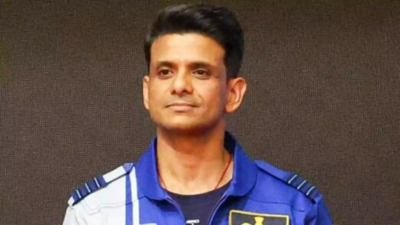The Axiom-4 mission successfully launched on Wednesday at 12:01 pm IST from NASA's Kennedy Space Center, embarking on its journey to the International Space Station (ISS).

Shubhanshu Shukla's space mission ignites national pride.
The mission, featuring India's Shubhanshu Shukla, alongside Anne McClain, Nichole Ayers, and Peggy Whitson, is transporting the four private Ax-4 astronauts to low Earth orbit. Docking is scheduled for 4:30 pm IST on Thursday at the orbital outpost's space-facing port on the Harmony module. The crew will spend two weeks conducting scientific research.
The entire journey from launch to docking is estimated to take approximately 28.5 to 29 hours. During their two-week stay at the ISS, the crew will focus on scientific research and outreach activities.
The journey began at Launch Complex 39A at NASA's Kennedy Space Center in Florida. This is the same location where Neil Armstrong started his historic Moon mission. The Ax-4 crew, wearing specialized flight suits, arrived at the pad and entered the Dragon capsule "C213". They then performed pre-launch verifications with SpaceX and NASA teams.
Approximately 35 minutes before departure, the Launch Director authorized fueling after activating the crew's emergency escape mechanism. The Falcon-9 received its supercooled liquid oxygen and RP-1 kerosene fuel. With five minutes remaining, Dragon transitioned to internal power. Perfect synchronization of all systems was required at countdown completion.
At T-0, Falcon-9's nine Merlin engines ignited, propelling the vessel skyward. Within sixty seconds, the craft exceeded the speed of sound. The critical "Max Q" phase occurred at 57 seconds, when the vehicle experienced peak aerodynamic stress.
The vessel continued its precise trajectory towards low-Earth orbit (LEO), and the crew experienced intensifying gravitational forces.
Approximately 150 seconds after launch, the first stage detached and returned to Earth, targeting an automated landing on an Atlantic Ocean platform. The second stage continued propelling Dragon towards orbit.
Ten minutes post-launch, Dragon separated and began independent flight. Its nose cone revealed essential navigation equipment. The craft reached speeds exceeding 27,000 km/hr, completing Earth orbits every 90 minutes.
The subsequent 20-24 hours involved precise orbital adjustments. Dragon performed calculated engine burns to align with the ISS trajectory. The craft utilized GPS, radar, and internal sensors for positioning.
Dragon approached the ISS systematically, pausing at designated waypoints from 400 meters inward. Ground control authorized each progression. At 20 meters, the craft's laser sensors and cameras guided it towards the Harmony module's docking port.
The connection occurred in two phases: magnetic soft capture followed by mechanical hard capture, establishing an airtight seal.
After thorough pressure and leak verification, the crew entered the ISS. The Ax-4 team began their two-week scientific program, including diabetes research. For Shubhanshu Shukla, this achievement represents both personal success and India's growing presence in space.
Newer articles
Older articles
 Team India Settles in Birmingham: Rahul's Mattress, Coaches' Strolls, and the Enduring Coffee Ritual
Team India Settles in Birmingham: Rahul's Mattress, Coaches' Strolls, and the Enduring Coffee Ritual
 Android Users Urged to Patch Devices Immediately Following Critical Security Flaws Alert
Android Users Urged to Patch Devices Immediately Following Critical Security Flaws Alert
 JPG to PDF: A Graphic Designer's Guide to Conversion & Best Practices
JPG to PDF: A Graphic Designer's Guide to Conversion & Best Practices
 Ashada Gupt Navratri 2025: Dates, Auspicious Timings, and Esoteric Significance Explained
Ashada Gupt Navratri 2025: Dates, Auspicious Timings, and Esoteric Significance Explained
 Skin Cancer Alert: How to Identify Suspicious Moles and Early Warning Signs
Skin Cancer Alert: How to Identify Suspicious Moles and Early Warning Signs
 IRCTC's AskDisha 2.0: AI Chatbot Streamlines Train Ticket Booking, Refunds, and Travel Information
IRCTC's AskDisha 2.0: AI Chatbot Streamlines Train Ticket Booking, Refunds, and Travel Information
 Bollywood's Mythological Muse: How Indian Epics Inspire Cinematic Storytelling
Bollywood's Mythological Muse: How Indian Epics Inspire Cinematic Storytelling
 Bollywood Flashback: Jackie Shroff Accused of Untoward Advance on Young Tabu at Danny Denzongpa's Party
Bollywood Flashback: Jackie Shroff Accused of Untoward Advance on Young Tabu at Danny Denzongpa's Party
 Popular Finance YouTuber's Account Hacked: Bitcoin Scam Alert and Security Tips
Popular Finance YouTuber's Account Hacked: Bitcoin Scam Alert and Security Tips
 X Cracks Down: Over Half a Million Accounts Suspended in India for Policy Breaches
X Cracks Down: Over Half a Million Accounts Suspended in India for Policy Breaches